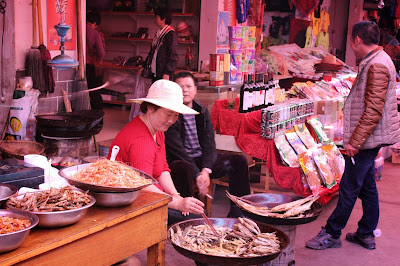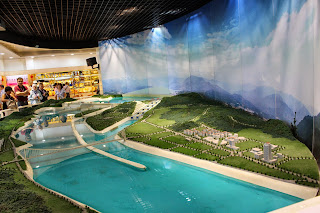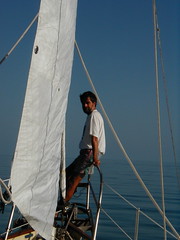After leaving Wuhan by plane, and then travelling to our cruise ship by bus from Wuhan to Jingzhou, we arrived in the evening and in time for supper on our Yangtze River Cruise Liner.
We were looking forward to this part of the trip, first because we like cruising (in case you have not guessed..) and also because this was going to be an incursion in one of the most pittoresque landscapes of the world: the Yantze river.
A rainy day - a first during this trip! Driving on the coach through small towns and villages on the way to Jingzhou gave us a very different impression of China from what we had seen so far. Small farms forming courtyards, deserted side roads, villages with no particular style to them...Compared to European's pittoresque villages, these places here looked very forlorn and somewhat depressing: as if all the efforts to create beauty was only for the Emperor and his/her court, and not part of the lives of the rest of the Chinese people. At least, that is how we saw it on this particular stretch...
For the next 5 days, the is will be our "home" (cabin 429), and (we assume) with a somewhat less intense schedule of sightseeing.
Not so!
In order to meet the 11am departure time, our morning excursion started at 7:30 - a visit to the ancient city of Jingzhou.
Jingzhou has been a transportation hub and commodity distribution center for 6,000 years. Ok, in the last few days, our tour guides made references to 2000 - 3000 BC, now this is up a notch! However, the city walls we visited in the rain are more recent; they were rebuilt in 1646, measure 9 metres high and 10 metres thick, with the perimeter of the wall extending for 9.3 kilometres! Of the gates and towers, unfortunately, only the Chaozong Tower remains in good condition, and becomes the focus for visitors; somehow it fits nicely into the more modern part of the city.
We took the opportunity to look around town while the group was still visiting the sights...went through grey alleys and landed on a market place...where there was little activity (it was late morning) but interesting sights...
This couple did not mind that we take their photos while they were cleaning fishes...
 The other attractions was the Jingzhou museum which has, among other 2000+ year artefacts (the woven silk work was just fascinating), a well-preserved 2,000-year-old male corpse of the Western Han Dinasty on display (there is also a female body, but access is restricted!). The corpse and other burial objects were excavated from the site of the Chu Kingdom in 1975. Due to the depth of burial and the absence of oxygen, the corpse was well preserved. The characters found in the tomb recorded that the man was a high official under the reign of the Wen Emperor of the Western Han Dynasty and that the exact year of his funeral was 167 BC!
The other attractions was the Jingzhou museum which has, among other 2000+ year artefacts (the woven silk work was just fascinating), a well-preserved 2,000-year-old male corpse of the Western Han Dinasty on display (there is also a female body, but access is restricted!). The corpse and other burial objects were excavated from the site of the Chu Kingdom in 1975. Due to the depth of burial and the absence of oxygen, the corpse was well preserved. The characters found in the tomb recorded that the man was a high official under the reign of the Wen Emperor of the Western Han Dynasty and that the exact year of his funeral was 167 BC! Nobody complained about being out of the rain and back on board the ship for the 11am departure. Indeed, we enjoyed sitting on our balcony, sipping a beer, and watch the scenery passing by ... and eventually, the sun was back again, misting river and valleys.
Nobody complained about being out of the rain and back on board the ship for the 11am departure. Indeed, we enjoyed sitting on our balcony, sipping a beer, and watch the scenery passing by ... and eventually, the sun was back again, misting river and valleys.There are iconic paintings of the Yantze river and in the next days we were going to admire miles and miles of these mountainous landscapes that are still inspiring Chinese artists like this one who paints with his palms dipped in ink!
 Because the source of the Yangtze was not ascertained until modern times, the Chinese have given different names to lower and upstream sections of the river. However, the Yangtze River (or, "Changjiang" in Chinese, literally, the "long river"), is the longest river in China, running 6,300 kilometers (3915 miles). It is also the third longest river in the world. Its basin, extending for some 2,000 miles from west to east and for more than 600 miles from north to south, drains a huge area in South China. The Yangtze also carries more water than any other river in China. Its source is in Tibet and it ends in Shanghai where it flows into the Pacific ocean...
Because the source of the Yangtze was not ascertained until modern times, the Chinese have given different names to lower and upstream sections of the river. However, the Yangtze River (or, "Changjiang" in Chinese, literally, the "long river"), is the longest river in China, running 6,300 kilometers (3915 miles). It is also the third longest river in the world. Its basin, extending for some 2,000 miles from west to east and for more than 600 miles from north to south, drains a huge area in South China. The Yangtze also carries more water than any other river in China. Its source is in Tibet and it ends in Shanghai where it flows into the Pacific ocean...We were so excited that we slept with our curtains and balcony doors open: we did not want to miss anything. Early on the first morning, we woke up to this rising sun ...
The Yantze is a busy river but none of that traffic affected the beauty of the site: on the contrary, it gave great perspectives ...
In order to visit the site of the Three Gorges Dam, we stopped at Sandouping, a town which is best known as the location of the Three Gorges Dam. We enter the town through the gates of the historic Huangling Temple. The very antique temple was already in disrepair when one of the Three Emperors ( Three Kingdoms Period (220 - 280B.C.), decided on its reconstruction when he passed by the Yellow Ox Gorge.
Legend has it that the temple was built mainly to commemorate the yellow ox that helped to dredge the Yellow Ox Gorge and release floods. It was built on the Yellow Ox Mountain and therefore named Yellow Ox Temple (Huang Niu Miao). Many relevant data on water-fluctuations levels of the Yangtze River are kept in the temple.
The first building of the Huangling Temple is the Mountain Gate. The gate was often attacked by severe floods and was finally destroyed in 1870. In 1886, it was rebuilt with wood and bricks.
As for Sandouping, it used to be a small fishing village until it was selected to be the site of the Three Gorges Dam. In 1999, at the peak of the construction, over 40,000 workers lived in Sandouping. At the time, special permits were required to enter the town. Most of Sandouping's inhabitants have been resettled from the areas flooded by the waters of the Three Gorges Reservoir, or, earlier, the Gezhouba Reservoir.
The Three Gorges Dam is the world's largest power station in terms of installed capacity (22,500 MW). As well as producing electricity, the dam is intended to increase the Yangtze River's shipping capacity and reduce the potential for floods downstream by providing flood storage space.
Indeed, floods always had been a major problem for the seasonal river of the Yangtze. Millions of people live downstream of the dam, with many large, important cities like Wuhan, Nanjing, and Shanghai situated adjacent to the river. Plenty of farm land and China's most important industrial area are built beside the river.
The Chinese government regards the project as a historic engineering, social and economic success with the design of state-of-the-art large turbines, and a move toward limiting greenhouse gas emissions. And so, it trained guides to educate population and visitors alike about the mega project. We enjoyed our guide, a woman who had 8 years of experience doing her job: like all the guides we had on this tour, she very well informed and could answer any question related to the project.
This below is a maquette highlighting the project sites.
Indeed, floods always had been a major problem for the seasonal river of the Yangtze. Millions of people live downstream of the dam, with many large, important cities like Wuhan, Nanjing, and Shanghai situated adjacent to the river. Plenty of farm land and China's most important industrial area are built beside the river.
The Chinese government regards the project as a historic engineering, social and economic success with the design of state-of-the-art large turbines, and a move toward limiting greenhouse gas emissions. And so, it trained guides to educate population and visitors alike about the mega project. We enjoyed our guide, a woman who had 8 years of experience doing her job: like all the guides we had on this tour, she very well informed and could answer any question related to the project.
This below is a maquette highlighting the project sites.


After such a "scientific and educational" tour, we had other concerns...such as finding beer for the evening! Luckily, every time we went on land for a tour, we went through little streets or alleys where vendors tried to entice us to buy their wares food items, beer, or crafts some a bit strange such as missiles toys as seen on right,...
We never tried street food; this was unfortunate but our excellent meal plan (3 huge meals per day) just did not make "snacking" possible between meals...

We were not the only river cruise ship doing this expedition: here we see another vessel of the Sinorama fleet!

 After visiting the Three Dams Project, the ship passed the 5-stages ship lock. Not our first lock passage but for many of our fellow passengers, this was a first. Our personal novelty was to do this passage while sipping a beer and not (!!!) getting our hands dirty!
After visiting the Three Dams Project, the ship passed the 5-stages ship lock. Not our first lock passage but for many of our fellow passengers, this was a first. Our personal novelty was to do this passage while sipping a beer and not (!!!) getting our hands dirty! Leaving the big ship at the dock, we embarked on a smaller boat for the excursion on a tributary of the Yanzte: Shennv Stream or Shennong Stream. The stream flows south, joining the Yangtze at the city of Badong. Originally the Shennong Stream watercourse consisted of a wild river traversing a tortuous alignment and flanked by almost vertical limestone cliffs; however, since the beginning of the construction of the Three Gorges Dam downstream on the Yangtze, the water level has risen approximately by more than 100 meters: and the landscape changed dramatically, of course.
Leaving the big ship at the dock, we embarked on a smaller boat for the excursion on a tributary of the Yanzte: Shennv Stream or Shennong Stream. The stream flows south, joining the Yangtze at the city of Badong. Originally the Shennong Stream watercourse consisted of a wild river traversing a tortuous alignment and flanked by almost vertical limestone cliffs; however, since the beginning of the construction of the Three Gorges Dam downstream on the Yangtze, the water level has risen approximately by more than 100 meters: and the landscape changed dramatically, of course.What we see now is a softly flowing river, with most of its vertical gorges now submerged. Nevertheless, the Shennong Stream and its three lesser Gorges retain still a charming, and at time, majestic scenery.

Our cruise guide pointed out these stalactites beautifying these amazing limestone mountains ...
 as well as to a small group of Rhesus monkeys sunning on the rocks ... (Rhesus macaques are not an endangered species; they have the widest geographic ranges of any nonhuman primate, occupying a great diversity of altitudes throughout Central, South and Southeast Asia. Inhabiting arid, open areas, rhesus macaques may be found in grasslands, woodlands and in mountainous regions up to 2,500 m in elevation. They are regular swimmers. with adults being able to swim over a half mile between islands).
as well as to a small group of Rhesus monkeys sunning on the rocks ... (Rhesus macaques are not an endangered species; they have the widest geographic ranges of any nonhuman primate, occupying a great diversity of altitudes throughout Central, South and Southeast Asia. Inhabiting arid, open areas, rhesus macaques may be found in grasslands, woodlands and in mountainous regions up to 2,500 m in elevation. They are regular swimmers. with adults being able to swim over a half mile between islands).
And really high up there, nested in the cliff, is a large a coffin! (Another 2000 year old artefact ...) With no noticeable support in the surrounding area, it is puzzling how the heavy coffins were placed in such a high place! Experts have speculated that the coffins might have been lowered down from the top of the mountain by ropes. Such hanging or nested coffins are not such an uncommon occurrence in southern China. The closer to the heavens, the close to the gods ... but only for the wealthy individuals who could afford such a luxury.
Also related to funeral sites are small pagoda temples which we often found in the vicinity of farms or private houses.
Back on the Yangtze, and immediately downstream of the ancient village Baidicheng, the River passes between the Chijia Mountain on the north and the Baiyan Mountain on the south. The point where the river passes between these mountains is called the Kuimen Gate and it is the entrance to the Qutang Gorge.
The Qutang Gorge is only 8 kilometres (5.0 mi) long, but it is also the narrowest of the Three Gorges. The widest point measures only 150 metres wide. The mountains on either side reach as high as 1,200 metres. This combination of narrow canyons among high mountains with several switchbacks in only 8 kilometres creates spectacular vistas, and the Qutang Gorge is often considered the most beautiful of all the Three Gorges.
Our last (land) excursion is to a hill along the back of the Yangtze River: Shibaozhai (meaning "Precious Stone Fortress").
Built in the Ming Dynasty, Shibaozhai consists of a gate, a pavilion and a temple. The gate is caved with some vivid reliefs. Within the gate is a 55m (158 feet) high 12-storey wooden pavilion to aid people in getting to the top of the hill, because prior to this, visitors to the temple had to be hoisted to the top using a system of chains. A spiral staircase took us to the top of the temple, from where we had a great view.
Now, with the dam construction, the Yangtze River had risen by more than 100m, which changed the image of the Shibaozhai considerably ...
before ....
and after ...


Getting there requires a walk over a suspended (and wobbly) bridge ... quite fun!
Every floor of the wooden structure contains interesting artifacts. Each of the 12 floors of the Shibaozhai is dedicated to a famous general of the Three Kingdoms period, a local scholar or a renowned Chinese poet.
On the way back to our ship, we meandered along the vendors alleys, exploring back streets, looking at a man gardening, a child playing while his mother washes laundry in the river...Day to day scenes of Chinese lives on the Yantze, mixing traditional, industrial and touristic perspectives.
And so, this is our last impression of China as we go to sleep that night.
The next day was going to be a long one with a flight from our current destination Chonquing to Shanghai and then Shanghai to Chicago and Chicago to Toronto!!!
At Shanghai airport, we enjoyed our last Chinese meal - a delicious soup with shrimp dumplings - together with a Stella Artois ... the beer fitted perfectly with our Chinese soup!!!
Bye, bye, China!















































